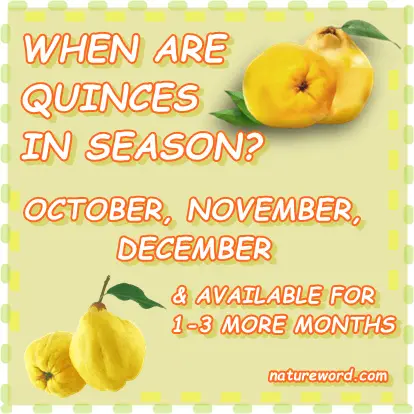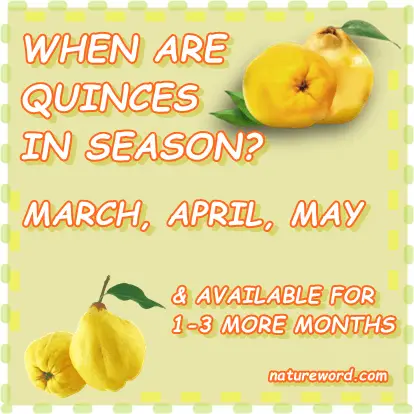Quinces are almost in season and a healthy seasonal fall and winter fruit to eat. But when exactly is quince season? What months specifically are quinces in season? When does quince season start and when does it end? How long does quince season last?
What is a quince?
A quince is a botanical and culinary fruit. Its cultivation dates back to antiquity and was once dubbed the ‘golden apple’, a reference to its beautiful yellow-golden color when ripe and quasi-likeness to apples.
The scientific name for quinces is Cydonia oblonga and they are indeed related to apples, but also pears, hawthorn berries, rose hips, plums, apricots and more.
Also see what is the nutrition of quinces for 100 grams.

When is quince season?
Quinces start coming into season right about now.
They are a seasonal fall and winter fruit which means they are in season in fall and winter. Depending on the region of cultivation, regional and yearly weather variations, quinces may come into season a month and a half into fall and last about one month into winter.
The actual season varies according to the hemispheres so that there are actually two seasons for quinces, one in each hemisphere.
Both quince season in the Northern hemisphere and quince season in the Southern hemisphere cover most of fall and the beginning of winter.
Just as important, while quince season is a month and a half into fall and about one month into winter, quinces are available for much longer.
The natural season includes the time that elapses from when the first quinces ripen and are ready to harvest and until the very last quinces are harvested and reach markets.
What goes beyond that also constitutes quince season, but it’s more of an extended availability, rather than an original season – since quinces have a naturally very hard flesh, they store extremely well and can last for months. This is why they continue to be available, aka in season, all throughout the cold season and up until spring.

When is quince season by month?
When are quinces in season in the Northern hemisphere by month?
In the Northern hemisphere, quinces are in season in the months of October, November and December. The season for quinces starts about a month and a half into fall, with the first fruits typically becoming available as early as mid-October.
Fruits continue to get harvested throughout November and December at the latest.
However, they are available for a lot longer, usually the whole of winter and up until spring.
Even though harvesting may be finished anywhere from early to mid-November to mid to late-December at the absolute latest, depending on the region and year, quinces remain available in January, February and March too, albeit in more limited amounts.
This is because they naturally have a very hard flesh which ensures the fruits store extremely well, for months even.
Note: However, exceptions exist. For example, in California, quince season starts in September in certain areas, early September to be more exact. This leads to a shift in seasonality, with quinces being in season up until early November at the latest.

When are quinces in season in the Southern hemisphere by month?
In the Southern hemisphere, such as in Australia and New Zealand, quinces are also in season fall and part of winter. More specifically, quinces are in season in the months of March, April and May which are fall months in the Southern hemisphere.
Depending on the region of cultivation and regional and yearly weather variations, they may continue to be available in the months of June and July and up until August at the latest.
Their very hard flesh ensures the fruits store extremely well, for months.
How long does quince season last?
Original quince season is generally about two months long, but can last less than that or more.
Depending on the tree variety, climate of the region of cultivation, size of the region of cultivation (which may include a broader range of temperature variations) and other factors, quinces may be in season for as little as one month to two months and a half and up to three months.
Not including an extra 1-3 months of availability due to the fruit storing extremely well.
For example, in the Northern hemisphere (US, UK) quince season typically starts mid-October at the earliest (when the first quinces are ripe and ready to harvest) and can last until early to mid-December (when the last quinces are harvested), adding up to a total of about two months of seasonality across the hemisphere. But there are exceptions, of course.
For example, in California quince season starts earlier than is typical of most other areas in the Northern hemisphere where the fruit are cultivated: at the beginning of September.
But it’s also over earlier than in other regions of cultivation: at the beginning of November. This adds up to about two months of seasonality for this region.
But if we were to consider a smaller region, quince season may both start and end in one month to one month and a half. If the region of cultivation considered is smaller, and the climate conditions are pretty much the same across said region, with little to no variation in temperature for example, then it’s possible to have quinces start ripening mid-October and the season last until mid-November. This would mean the season would only be one month total for the region.
Conversely, if winter is mild, quinces start ripening on schedule, around mid-October, but can last on the tree all of December, some fruits even longer, making the natural season last longer than two months. Leaving quinces on the tree even after frost sets in will serve to blet the fruit, rendering it more palatable and more suitable for consumption in its raw form. Bletting is essentially letting fruit overripen and/or decay so that they may soften, and freezing temperatures do just that in quinces.
Of course, this is not a common practice in commercial cultivation which oversees quinces being harvested as soon as they’re ready so they are in ideal shape – ripe, but perfectly firm and unblemished.
More About quince season
Quinces have been cultivated since Antiquity and still are across the globe. Any region with a temperate climate, and slightly warmer or colder than what is typical of a temperate climate, is suitable for cultivating quinces which are very hardy trees.
Not just this, but there are about 25 different varieties of quince, Cydonia oblonga, with different flowering, fruiting and harvesting times. Add the natural variations in temperature and other weather conditions, yearly and regional, and you get a very interesting seasonality for the fruit.
Quinces are naturally fall and winter fruit and in season in fall and winter months, whether it’s the Northern or the Southern hemisphere. They keep for another few months, usually 1 or two, and in rare occasions even up to 3 months. Original season plus extended availability are both counted towards what is generally referred to as ‘quince season’.
With this in mind, don’t be surprised if you read somewhere that quinces are in season October through December and somewhere else that quinces are in season October through March. Both pieces of info are technically correct.
